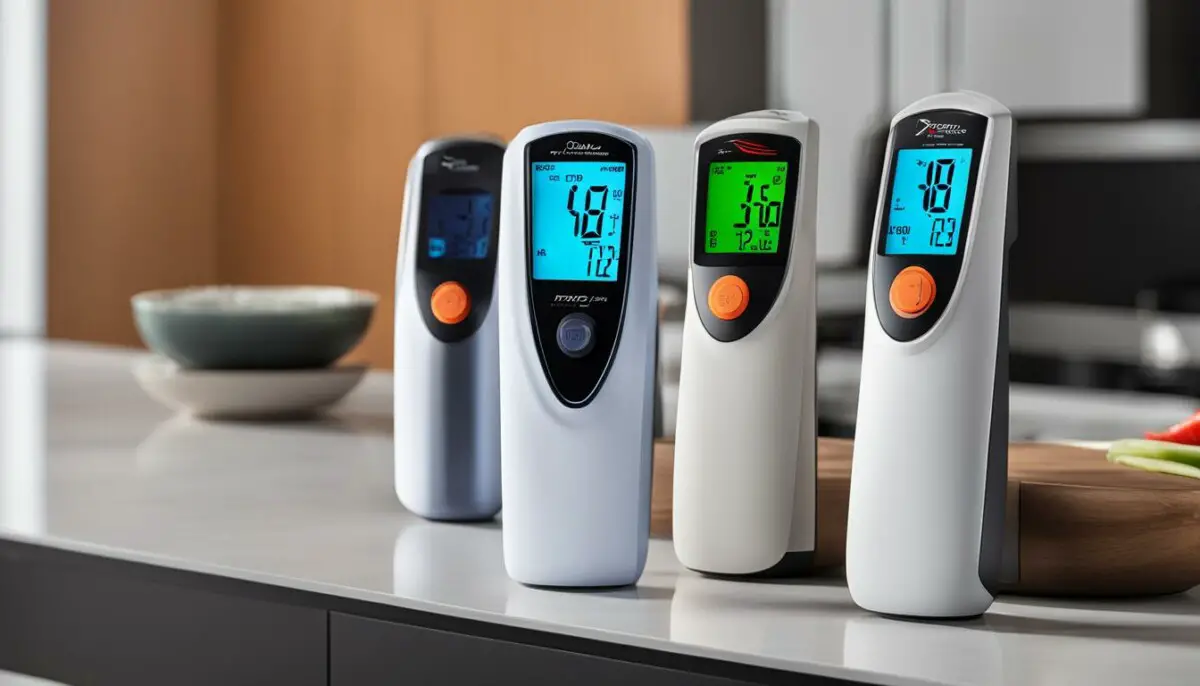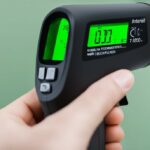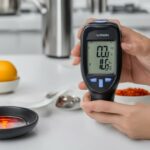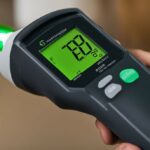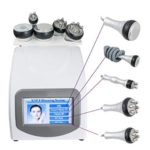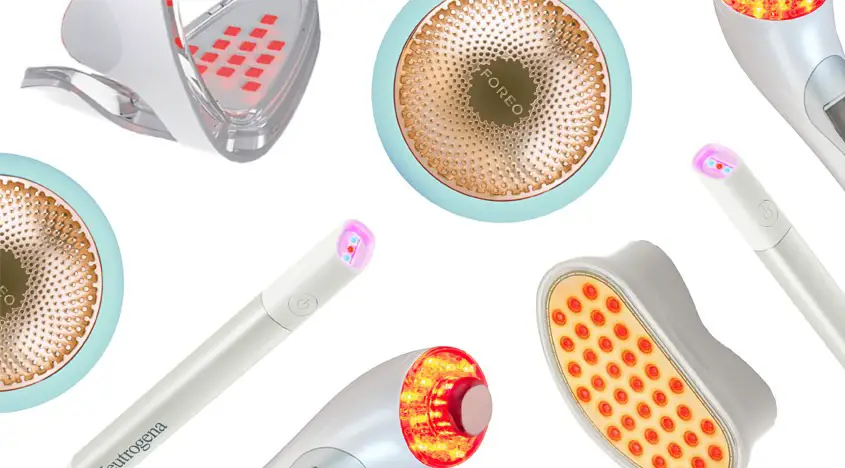Last Updated on 5 months by Francis
Are infrared thermometers reliable? This question often comes to mind when considering using these quick and convenient tools for measuring body temperature. Infrared thermometers use infrared radiation emitted by the human body to calculate temperature, but their reliability can vary depending on various factors.
While infrared thermometers are reasonably accurate when used correctly, it’s important to understand their limitations and how to use them accurately in order to obtain reliable results. In this in-depth guide, we will explore how infrared thermometers work, their accuracy, and the considerations to keep in mind when using and purchasing one.
Contents
Key Takeaways:
- Infrared thermometers provide quick and convenient measurements of body temperature.
- Their reliability can vary depending on factors such as user error and environmental variables.
- Accuracy standards for non-contact infrared thermometers are outlined by the FDA.
- Proper usage and understanding of limitations are crucial for reliable results.
- Considerations when purchasing include accuracy, ease of use, and brand reputation.
How Do Infrared Thermometers Work?

Infrared thermometers work by detecting the infrared radiation emitted by the body, which increases with temperature. They use a lens to direct the infrared radiation towards a thermopile, which converts thermal energy into an electrical signal. This signal is then measured to determine the body temperature, which is displayed on a digital screen. It is important to note that the accuracy of infrared thermometers can decrease over time due to “drift,” and periodic recalibration may be necessary.
Unlike traditional thermometers that rely on direct contact with the body, infrared thermometers provide a non-invasive way to measure temperature, making them more convenient and hygienic. By simply pointing the thermometer at the forehead or ear, the device can quickly and accurately measure body temperature without any physical contact. This feature makes infrared thermometers particularly useful in situations where contact-based methods may not be practical or desirable, such as when measuring the temperature of a restless child or screening a large number of people.
It is crucial to understand the precision of infrared thermometers when interpreting their measurements. While they can provide an accurate reading of surface body temperature, they may not always reflect the internal temperature accurately. Factors such as the distance between the thermometer and the body, the angle of measurement, and environmental conditions can affect the precision of the readings. It is recommended to follow the manufacturer’s instructions carefully and consider these factors when using an infrared thermometer to ensure accurate and reliable results.
| Advantages | Limitations |
|---|---|
|
|
Infrared Thermometer Accuracy: What You Need to Know
When it comes to measuring body temperature, infrared thermometers offer quick and convenient solutions. However, it’s important to understand their accuracy limitations to obtain reliable results. According to FDA guidelines, clinical non-contact infrared thermometers must meet certain accuracy standards. Most forehead thermometers are accurate within a range of three degrees Fahrenheit. Ear thermometers, on the other hand, have shown to be more accurate than forehead thermometers in clinical studies. However, it’s essential to note that oral and rectal thermometers usually have a higher level of accuracy and reliability compared to no-contact infrared thermometers.
The accuracy of infrared thermometers can be affected by various factors, including user error and environmental variables. Factors such as the angle or distance at which the thermometer is used, as well as the presence of sunlight or obstructions on the forehead, can impact accuracy. It’s important to consider these factors when using an infrared thermometer to ensure accurate temperature readings.
While infrared thermometers may not offer the same level of accuracy as oral or rectal thermometers, they still provide valuable information. They are particularly useful for screening large groups of people or monitoring the temperature of a fidgety child. However, if you obtain alarming or suspicious results with an infrared thermometer, it’s recommended to verify them with a more accurate method, such as an oral or rectal thermometer.
How to Use an Infrared Thermometer Correctly?
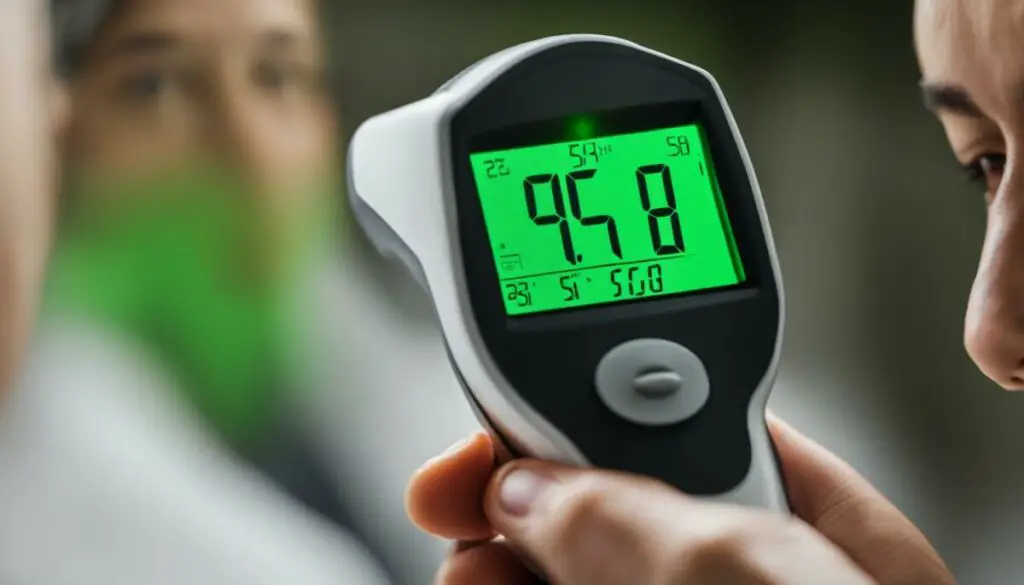
Using an infrared thermometer correctly is crucial to ensure accurate temperature measurements. The Food and Drug Administration (FDA) advises following the manufacturer’s instructions carefully. Here are some essential steps:
- Ensure the thermometer is used indoors, away from direct sunlight or drafts, as external factors can affect the readings.
- Allow the thermometer to acclimate to the room temperature for at least 30 minutes before use.
- Clean the forehead from any obstruction, such as sweat or hair, before using a forehead thermometer.
- Position the thermometer perpendicularly to the forehead for accurate results.
- For ear thermometers, carefully insert the probe into the ear canal and follow the manufacturer’s instructions.
By following these guidelines, you can optimize the performance of your infrared thermometer and obtain reliable temperature readings.
It’s important to note that different types of infrared thermometers may have specific usage instructions. Always refer to the user manual or consult the manufacturer for any additional guidelines.
Common Mistakes to Avoid
When using an infrared thermometer, there are a few common mistakes to avoid to ensure accurate results:
- Avoid measuring temperature immediately after eating or drinking, as it can affect the readings.
- Do not measure temperature if the person has been exposed to extreme temperature conditions, such as being outdoors on a hot day or just coming in from the cold.
- Ensure the thermometer is held steady and aimed directly at the measurement area.
- Always check the battery levels of the thermometer to ensure accurate readings.
By practicing proper usage techniques and avoiding these common mistakes, you can effectively utilize an infrared thermometer and obtain reliable temperature measurements.
Advantages and Limitations of Infrared Thermometers

Infrared thermometers offer several advantages that make them popular for measuring body temperature. One of the main benefits is their speed and convenience. Unlike traditional thermometers that require physical contact, infrared thermometers can provide temperature readings without touching the person. This makes them particularly useful for screening large groups of people or monitoring the temperature of a fidgety child.
However, it’s important to consider the limitations of infrared thermometers as well. One major limitation is the potential for user error. The accuracy of these thermometers can be affected by factors such as the angle or distance at which they are used. Additionally, environmental variables like the presence of sunlight or obstructions on the forehead can also impact their accuracy. Therefore, it’s essential to follow the manufacturer’s instructions carefully and take these factors into account when using an infrared thermometer.
In conclusion, while infrared thermometers offer speed and convenience, they do have limitations that can affect their accuracy. Understanding how to use them correctly and considering the potential factors that may impact their readings is crucial. If accurate and reliable temperature measurements are required, verification with oral or rectal thermometers is recommended. As with any medical concerns, it’s always important to consult with a healthcare professional for advice and evaluation.
Infrared Thermometers for Different Age Groups

Infrared thermometers are versatile tools that can be used to measure body temperature in individuals of all ages, including newborns, children, and adults. They offer a non-invasive and convenient way to obtain temperature readings without the need for direct contact or invasive methods. This makes them particularly beneficial for young children who may find traditional thermometers uncomfortable or challenging to use.
However, it is important to consider that the accuracy of infrared thermometers may vary depending on the age group and surrounding conditions. While studies have shown that infrared thermometers can provide reasonably accurate results in many cases, it is still recommended to verify any alarming or suspicious temperature readings with more accurate methods such as oral or rectal thermometers.
The Importance of Verification
For newborns and infants, it is especially crucial to use caution when relying solely on infrared thermometers. These age groups may have higher variations in body temperature, and accurate readings are essential for proper diagnosis and treatment. Therefore, it is advisable to consult a healthcare professional and use additional temperature measurement methods for validation when dealing with infants.
It is important to note that while infrared thermometers offer convenience and ease of use, they should not replace professional medical evaluation and diagnosis. When in doubt, always seek medical advice.
By considering the limitations of infrared thermometers and using them in conjunction with other methods when necessary, individuals can make informed decisions about their health and the health of their loved ones. It is important to prioritize accuracy and consult with healthcare professionals for proper medical advice and evaluation.
Comparison with Other Types of Thermometers

Infrared thermometers are just one of several options available for measuring body temperature. Other common types include oral, rectal, axillary (armpit), and tympanic (ear) thermometers. Each type has its own advantages and limitations. Infrared thermometers offer the convenience of non-contact measurement but may have reduced accuracy compared to oral or rectal thermometers. The choice of thermometer depends on factors such as age, comfort, and accuracy requirements.
Table:
| Thermometer Type | Advantages | Limitations |
|---|---|---|
| Infrared Thermometer | – Non-contact measurement | – Reduced accuracy compared to other types – Affected by environmental factors |
| Oral Thermometer | – Widely available | – Requires contact with mouth – Can be difficult for young children |
| Rectal Thermometer | – Most accurate | – Invasive and uncomfortable – Not suitable for self-measurement |
| Axillary Thermometer | – Non-invasive | – Less accurate than oral or rectal thermometers – Tends to underestimate body temperature |
| Tympanic Thermometer | – Quick and easy to use | – Requires proper positioning to obtain accurate readings – Affected by earwax buildup |
Considerations for Choosing the Right Thermometer
- Age: Infrared thermometers are suitable for individuals of all ages, while rectal thermometers are typically used for infants and young children.
- Comfort: Some people may find oral or rectal thermometers uncomfortable, making non-contact options like infrared or tympanic thermometers preferable.
- Accuracy: If accuracy is crucial, especially for medical purposes, oral or rectal thermometers are generally recommended.
- Availability: Infrared thermometers are widely available and easy to use, while specialized thermometers like tympanic thermometers may require professional medical settings.
Remember, the choice of thermometer depends on your specific needs and preferences. It’s important to consider factors such as age, comfort, and accuracy requirements when selecting the right thermometer for you or your family.
The Importance of Verification and Medical Advice

While infrared thermometers can provide quick and convenient temperature readings, it is important to verify any alarming or suspicious results with a more accurate method, such as an oral or rectal thermometer. These methods are generally considered to be more reliable. It is also crucial to seek medical advice if you or a family member is experiencing fever or other symptoms. Infrared thermometers should not replace professional medical evaluation and diagnosis.
To ensure accurate temperature measurement and appropriate medical advice, consider the following:
- Verify the results: Infrared thermometers can occasionally produce inaccurate readings due to factors like user error or environmental variables. If an infrared thermometer detects a high temperature, it is recommended to confirm it using an oral or rectal thermometer to rule out any potential errors.
- Consult with a healthcare professional: While infrared thermometers are useful for initial temperature screening, they should not be used as a standalone diagnostic tool. If you or a family member is experiencing symptoms such as fever, it is important to consult with a healthcare professional who can provide a comprehensive evaluation and accurate diagnosis.
- Follow medical guidelines: It is essential to follow the guidance of healthcare professionals regarding temperature monitoring and fever management. They can provide specific instructions depending on the individual’s age, medical history, and overall health condition.
Infrared thermometers can be a valuable addition to your home or workplace for quick temperature screening. However, it is crucial to use them as part of a comprehensive approach to health monitoring and seek professional medical advice when necessary.
Table: Comparison of Temperature Measurement Methods
| Method | Accuracy | Reliability | Convenience |
|---|---|---|---|
| Oral Thermometers | High | High | Requires cooperation |
| Rectal Thermometers | High | High | Requires cautious handling |
| Axillary Thermometers | Moderate | Moderate | Easier for infants |
| Tympanic Thermometers | Moderate | Dependent on proper positioning | Quick but requires proper positioning |
| Infrared Thermometers | Moderate | Dependent on user technique and environmental conditions | Quick and non-invasive |
Considerations for Purchasing an Infrared Thermometer
When purchasing an infrared thermometer, there are several factors to consider to ensure that you are getting the best option for your needs. Here are some key considerations to keep in mind:
Accuracy
Accuracy is one of the most important factors when choosing an infrared thermometer. Look for models that have been tested and proven to provide reliable temperature measurements. Reading reviews from trusted sources can help you determine the accuracy of different brands and models.
Ease of Use
Consider how easy the thermometer is to use, especially if you plan to use it on multiple individuals or frequently. Look for features such as clear and intuitive displays, easy-to-use buttons, and ergonomic design. Some thermometers may also offer additional features like memory recall or silent modes, which can enhance the user experience.
Brand Reputation
Choosing a thermometer from a reputable brand is important to ensure the quality and reliability of the product. Look for brands that have a history of producing accurate and durable thermometers. Reading customer reviews and checking for any recalls or safety concerns can help you make an informed decision.
By considering these factors, you can choose an infrared thermometer that provides accurate and reliable temperature measurements, making it a valuable tool for monitoring and ensuring the wellbeing of yourself and your loved ones.
Conclusion
Infrared thermometers can be reliable tools for measuring body temperature when used correctly. Their speed and convenience make them highly useful in various situations. However, it’s important to recognize their limitations and take precautions for accurate readings.
One must remember that infrared thermometers can be affected by user error and environmental variables, such as the angle or distance at which they are used. To ensure accuracy, it is recommended to verify any alarming or suspicious results with a more accurate method, such as an oral or rectal thermometer. Seeking medical advice from a healthcare professional is also crucial for proper evaluation and diagnosis.
When purchasing an infrared thermometer, it’s essential to consider accuracy, ease of use, and brand reputation. Reading reliable reviews can help identify the best options available. Additionally, choosing a thermometer that meets necessary regulatory standards, like FDA guidelines, ensures reliability.
In conclusion, while infrared thermometers offer convenience and speed, they should be used alongside other methods for verification and medical evaluation. By understanding their limitations and following proper usage guidelines, one can rely on infrared thermometers for temperature measurements.
FAQ
Are infrared thermometers reliable?
Infrared thermometers can be reliable tools for measuring body temperature when used correctly.
How do infrared thermometers work?
Infrared thermometers work by detecting the infrared radiation emitted by the body and converting it into an electrical signal to calculate the temperature.
Are infrared thermometers accurate?
While infrared thermometers can be reasonably accurate when used correctly, their accuracy may vary depending on various factors.
How to use an infrared thermometer correctly?
To use an infrared thermometer accurately, it is important to follow the manufacturer’s instructions, ensuring proper positioning and environmental conditions.
What are the advantages and limitations of infrared thermometers?
Infrared thermometers offer the advantages of speed and convenience but may have reduced accuracy compared to other types of thermometers. User error and environmental factors can affect their accuracy.
Can infrared thermometers be used on different age groups?
Yes, infrared thermometers can be used on individuals of all ages, but their accuracy may vary depending on the age group and surrounding conditions.
How do infrared thermometers compare to other types of thermometers?
Infrared thermometers offer non-contact measurement but may have reduced accuracy compared to oral or rectal thermometers. The choice of thermometer depends on factors such as age, comfort, and accuracy requirements.
Why is verification and medical advice important when using infrared thermometers?
It is important to verify any alarming or suspicious results with a more accurate method and to seek medical advice for proper evaluation and diagnosis.
What should I consider when purchasing an infrared thermometer?
Factors such as accuracy, ease of use, brand reputation, and meeting necessary regulatory standards should be considered when purchasing an infrared thermometer.

